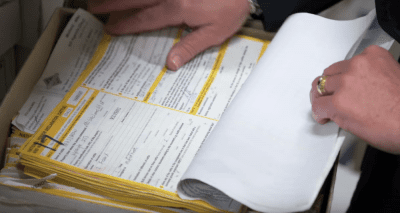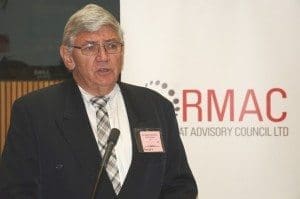The Australian cattle industry should never lose sight of the reasons why a uniform system of National Vendor Declarations (NVDs) was fought for and implemented, two industry leaders who helped to drive its introduction have warned.
Ross Keane and Malcolm Foster were among the voluntary industry representatives in the late 1990s who helped to drive the introduction of NVDs and the underpinning Livestock Production Assurance program.
Both former RMAC chairs say the initiatives have allowed Australian beef to enjoy a unique and competitive food safety advantage in global markets for more than two decades.
Their comments come in the wake of feedback from agents and processors indicating that surprisingly large numbers of producers are still failing to fill out NVDs correctly when selling cattle.
The high non-compliance rate is causing considerable unnecessary expense and loss of efficiency as staff have to go back to vendors and ensure declarations are correctly completed and re-signed before cattle can be sold or processed.
In the wake of those reports Beef Central spoke with two former industry leaders to discuss the reasons why NVDs and the Livestock Production Assurance system that underpins them were initially introduced in the late 1990s.
At the time Ross Keane was the General Manager, Livestock, of major meat processor Australia Meat Holdings (bought in 2007 by JBS Swift), and Malcolm Foster was the managing director of Rangers Valley feedlot and the chair of the inaugural Red Meat Advisory Council (RMAC).
They were part of a wider group of voluntary industry representatives from each sector – from production and lot feeding to processing, retailing and exporting – who saw the need for a credible and practical quality assurance system to underpin the food safety standards of Australian beef in domestic and global markets.
Far from being something that was imposed on industry by a handful of people in North Sydney, as some critics have suggested, the program was initiated, developed and driven by elected representatives of every sector of the industry, Mr Keane said.
Mr Keane said most processors at the time had their own individual declaration forms for vendors selling slaughter cattle to sign, while there were no such declarations in place for store cattle.
“So you had this plethora of vendor declarations, and the other big issue was back in those days in Queensland you had to write out a way bill, in Victoria you did nothing, in NSW it was something different again.
“So we had this dream that we didn’t think would come to life, and that was that we could get the travelling stock statement welded into the document that we needed for description of the animal, so one piece of paper to do the lot.
Mr Keane recalls there were many industry representatives involving the whole supply chain including from breeders, fatteners. feedlotters, retailers, butchers, right through to grinders for McDonald’s, all of whom met and teased out the issues several times over a 12 month period.
“And we finally got there,” he said,
“And it was because there was good cooperation from different parts of the industry”.
Malcolm Foster who chaired the committee said the industry had just come through a difficult industry restructure (which resulted in the transition from AMLC to MLA and the creation of the existing RMAC industry structure).
That had been a ‘very cathartic process’ which had led to a strong degree of common understanding and a spirit of unity among the different red meat sectors at the time.
“I’d have to say, there was a lot of table banging and shouting and yelling and carrying on during that transition process, as everybody jockeyed for their respective positions in the meat industry structure,” he said.
“But when it was finished there was a fair degree of camaraderie between peak councils and the industry.
“Everybody around that table that been through a very difficult process, we had a new industry structure, and we were all looking forward to it going on into the future and this process started almost straight after it.
“So there was a fair degree of common understanding amongst the industry participants that was a major reason why it supported.
“I am not sure that exists today.”
The new measures caused no small degree of consternation and pushback when they were rolled out, as producers were asked to fill out paperwork they had never had been required to before.
Mr Foster said the level of cooperation and the commitment from all sectors to create over-arching quality assurance for the industry was a crucial reason the program got up. He said the industry owed a debt of gratitude to people like Kev Roberts and Mr Keane for their enormous work during the implementation phase to ensure it was understood and supported, despite “the many rocks in the road” along the way.
In his view, a key reason why the LPA succeeded despite not having legislative backing as the decision at the time by most processors to say they would no longer buy livestock that were not accompanied by an LPA NVD.
“That was the market mechanism that tied the NVD to quality assurance,” Mr Foster said.
The underpinning of LPAs with random on-property audits and the use of an industry wide NVD meant meat processors could pack meat with confidence, knowing that “when it goes to the market of destination it complies with everything that market requires.”
Mr Foster said the LPA program, together with NLIS and industry QA programs such as the National Feedlot Accreditation Scheme, had given Australia “a huge advantage”, and one which most other countries had yet to emulate.
Mr Keane, who travels frequently to export markets both in his industry roles and as a director of agri-travel company Quadrant Australia, said there was no doubt other countries were envious of the world-leading integrity systems Australia had in place.
But it was also clear many were working hard to close that gap, he said.
“When I get to go and see graziers or feed lotters in the US, they tell me they’re envious of what we have got, and say they wish we could get what you have in our country.
“And when I go to South America it is clear they are working to catch us.”
Mr Foster said the fact other countries were trying to catch up was a clear indication of the value the program provided to Australia and why it was worth supporting.
“They wouldn’t be trying to emulate it if it wasn’t worth anything,” he said.
“It is worth something, there is no question that our customers are saying to our competitors, well I’ll buy Australian because of this, what’s your scheme?
“There is no question people buy Australian red meat with a great deal of confidence with respect to the health and safety issues and all of the things that are considered important.”
Mr Keane said the next challenge for Australia is to improve the digital version of NVDs which had significant potential to improve non-compliance rates.




Sorry Bill, ‘clean and green’ doesn’t really have the effect in a lot of markets that trendy city slickers here and in Europe think it does.
Go speak to some consumers in some of our Asian markets, they couldn’t give a rats about ‘clean and green’. They just want good, tasty and affordable meat.
those price comparisons and statements are based on the unknown and some of them are incorrect. Clean and green must have some effect on marketing when we have a emerging middle class world wide
The so called benefits of LPA and NLIS has not been passed onto the producer.
The first consignment of cattle I sold were angus steers in 1982 and got $1.42kg live without LPA and NLIS. Now 36 years later and with an average inflation rate of 3.5%(very low) I should be getting $4.90 live. The absurdity of LPA is that about 1% of producers are audited each year. The new biosecurity modules have no relevance for food safety and there are more modules in the pipeline that will tangle producers up in so much red tape they will not be able to conduct their business in an efficient manner.
The NLIS database is in a shambles .I purchased cattle that had been on my property on agistment for 5 months and had not been transferred from their place of birth .I have received 5 warnings of lots cattle that have been sold off my property in the last month alone that were not on my property. One producer told me of a recent EU audit that determined he should have 9000 cattle on his properties he actually had less than 4000.Another told of tag loss rates of 52% from when cattle were tagged at branding then sold as aged cattle,I could go on.
We have lost market share in our high value market of South Korea to the USA without LPA or NLIS and they are now competing fiercely in Japan.
NLIS has now taken over $1b from cattle producers pockets and is the most costly white elephant ever inflicted on cattle producers.
On my recent travels to the USA I met many ranchers none of whom were envious of LPA or NLIS but were enjoying cattle prices 40% higher than ours.
I question the statement that it was initiated by elected representatives I have never elected a Cattle Council director yet I am forced to fund them through the beef tax past and present.
One of the 7 senate recommendations was to get rid of RMAC its a pity the National Party reneged on their promise .
From my understand LPA can trace it’s origins way back to the 1980’s when Cattle care was developed. Cattle care was a voluntary QA system requiring similar record keeping by producers as required by LPA. For that reason I do not know of anyone in my area who ever took it up voluntarily, I remember back in the 1990’s going to a QCare seminar paid for by Murgon meatorks, We were told it was a far simplified system then cattlecare. In the end Murgon meatworks went broke and I never heard about QA again. Until NLIS came about and then LPA was thrust upon producers.
Thing is though, it would be interesting to know how much LPA paperwork the most ardent supporters of the scheme actually do? Have they done a biosecurity form (and reviewed it annually), have they done complete and accurate records (including mapping of herbicide use) of any and all chemicals used on their property. Have they done an up to date property map showing risk locations along with their property risk assessment. And so on and so on.
I know LPA has it’s good points, but for some producers if they were to do it by the book, it would be a time consuming potentially expensive burden with no positive outcome and it is only getting worse as time goes on and the scheme gets more and more bloated. It is time it needs a thorough review preferably to make it more streamlined, practical and simple.